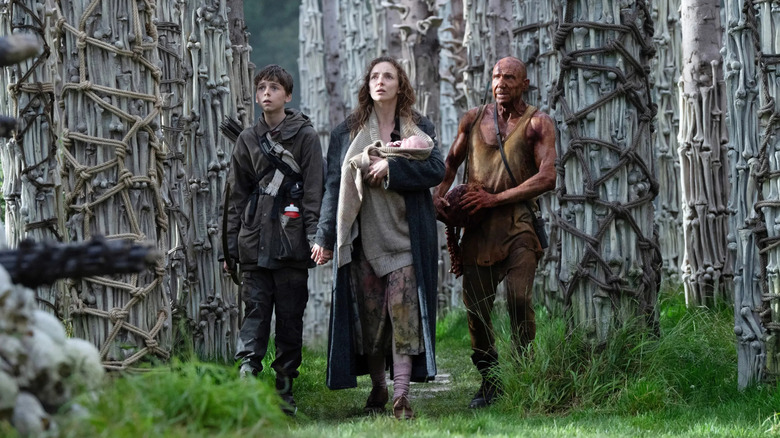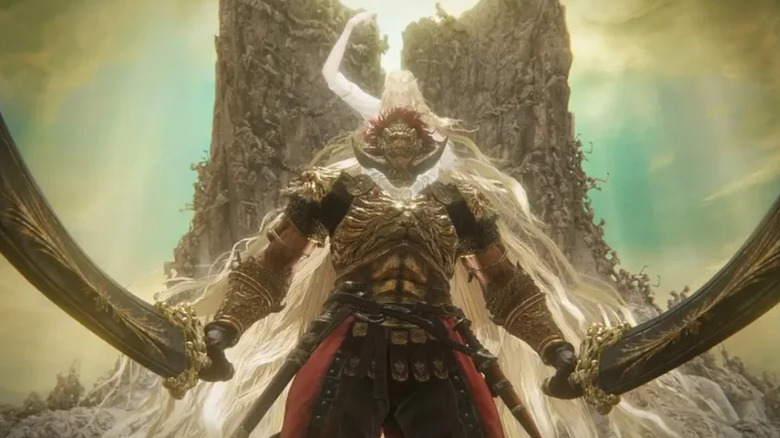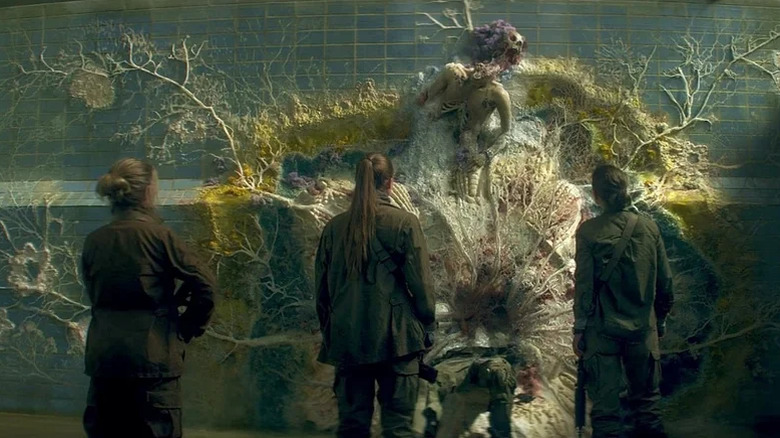28 Years Later Reveals Why An Elden Ring Movie Could Actually Work
When the news arrived that A24 and Alex Garland are turning "Elden Ring" into a feature film, there was cause for skepticism. The development makes sense, of course, as video games are the new gold mine in Hollywood. It is an annoyingly repeated fact that the video game industry makes more money than music and film, so it's about time studios recognized the untapped potential of adapting video games — as long as they don't strip away everything fans like about them for some weird experimental mess like the live-action "Super Mario Bros." (which, yes, has its defenders) and the 1995 "Mortal Kombat."
Part of what makes the "Elden Ring" video game so popular is that it is set in an epic world with huge landscapes and a vast mythology. The game is also a grueling and unforgiving experience that punishes you for everything, making you feel miserable about spending money on a title that relishes in mocking your failures. This is to say, adapting "Elden Ring" is a daunting task, one that is hard to really picture being successful without spending hundreds of millions of dollars. Do you adapt the gameplay or just the setting? How do you even begin to capture the visuals of this vast world?
We don't know any details about the adaptation or what Garland's plans are, but after watching "28 Years Later," I am now hopeful that an "Elden Ring" movie can actually work under his watchful eye.
28 Years Later features a vast post-apocalyptic world similar to the one in Elden Ring
Garland, as a writer, finally reunited with director Danny Boyle for "28 Years Later," a gruesome and surprisingly emotional horror movie that brings the pair back to the non-zombie post-apocalyptic universe they introduced in 2002's "28 Days Later." The latter, of course, is the film that revolutionized the zombie genre by introducing fast zombies that are actually people infected with a virus, as opposed to literal reanimated corpses. And while Boyle is not directing "Elden Ring," it's easy to see how the elements that make "28 Years Later" work can be applied to the post-apocalypse of "Elden Ring."
Yes, post-apocalypse. As fantastical as the game's setting is (with its enormous creatures, elaborate set designs, impossible locations, colossal monuments, and a giant tree that can be apparently seen from everywhere), "Elden Ring" is very much a post-apocalyptic story. Part of the uniqueness of the game's universe is that it's a world in crisis in the wake of a great calamity, but it's not yet past the point of total collapse. Instead, there is plenty of life, it's just desperately fighting for survival, with everyone you encounter either miserable or having turned feral and violent. Much like in "28 Years Later," there are communities and lifeforms to be found; there's just nothing resembling normalcy, and everything that was once considered great is in ruins.
"28 Years Later" weaponizes this backdrop, which is far removed from the empty but still otherwise intact London streets and monuments glimpsed in "28 Days Later." Instead, by picking up with the story nearly three decades later, the film introduces a landscape that is practically unrecognizable. What little we see of the U.K. of old is either in ruins, covered in vegetation, or severely decayed. Amidst the vast terrains, empty fields, and forests lie an old cabin, an angel statue no one remembers the true purpose of, and even a temple of bones with a massive tower of skulls.
An "Elden Ring" movie should similarly take place in an environment full of things that were once beautiful and terrifying but have fallen into disrepair, be they lavish castles or gigantic fortresses. Indeed, the scene in "28 Years Later" where the character Spike (Alfie Williams) and his mother Isla (Jodie Comer) walk across a field before coming across the ruins of a church feels like it was lifted straight out of Hidetaka Miyazaki's epic game.
An Elden Ring movie should be all about the visual storytelling (like Garland's previous work)
Truly, what is "Elden Ring" if not a zombie movie in video game form? Its setting is immense and relatively empty, yet there are plenty of reminders of the world that was. Danger is not necessarily on screen all the time, but it is still ever-present, and untold creatures can come at you at any moment.
Much like "Elden Ring," a lot of the world-building in "28 Years Later" happens implicitly and visually. There are also hints of a much larger world (as well as the ways that world has changed in the past three decades), but the movie doesn't explicitly spell anything out. Garland took a similar approach on his 2018 directorial effort "Annihilation," which tells a simple story set against a much bigger and complicated backdrop we learn little about but see plenty of, leaving it to viewers to interpret and wonder about the setting as they will. This is the key to adapting "Elden Ring," which is rich in mythology and lore, most of which you can easily miss if you're not paying careful attention.
Watching "28 Years Later," with its expansive landscapes and scattered ruins, made me think of the experience of walking through the daunting fields of "Elden Ring" and seeing an interesting landmark in the distance (that is, an alluring structure promising danger and rewards). If Garland is going to attempt to distill the essence of the game into a feature film with a budget of less than $150 million, then he would do well to borrow a page from the same book he used for his and Boyle's zombie epic.
"28 Years Later" is currently playing in theaters.


